

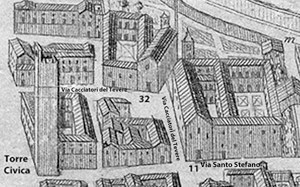
Detail from the plan (ca. 1675) of Città di Castello
by Filippo Titi (Biblioteca Comunale “Giosue Carducci”)
A group of female penitents bought property here in 1300. In 1310, Bishop Ugolino Gualterotti granted them permission to build a nunnery here and placed them under the Augustinian Rule. Their church [32], which was dedicated to all the saints (Ognissanti or Tutti i Santi), was immediately adjacent to the Convento di Sant’ Agostino [11].
The nuns fled the city for Cortona during the Ghibeline revolt of 1326. After their return, Bishop Ugolino della Branca, granted them permission to have a cemetery (in 1340).
Beatrice and Olimpia, the daughters of Alessandro Vitelli and Angela Rossi, were nuns here in the 16th century, and the former became the abbess.
The nunnery and the Convento di Sant’ Agostino were essentially destroyed in the earthquake of 1789.
Istituto delle Salesiane
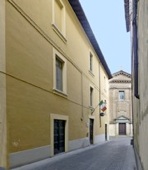
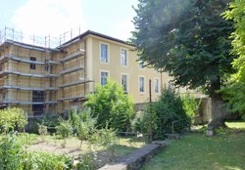
Facade in Via Cacciatori del Tevere View of Institute from the
with Sant’ Agostino ahead nuns’ garden to the rear
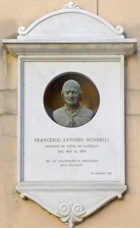
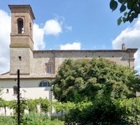
Art from SS Ognisanti
Ognissanti Triptych (1417 )
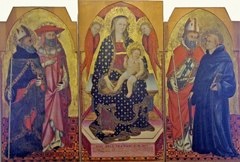
This triptych, which is dated by inscription, was documented in the nuns church in 1868, at which time it had already been dismembered. It was transferred to the civic collection before 1899 and is now in the Pinacoteca Civica. The panels depict:
-
✴the Madonna and Child enthroned with two seraphim (in the central panel);
-
✴SS Augustine and Jerome (in the left panel); and
-
✴SS Floridus and Leonard (in the right panel).
Ognissanti Altarpiece (ca. 1504 )
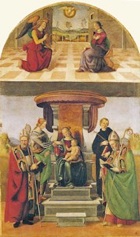
-
✴the Annunciation, in the upper lunette; and
-
✴the Madonna and Child enthroned with: St Catherine of Alexandria (to whom the baby Jesus gives a ring), St Nicholas of Tolentino and two bishop saints.
The work draws on contemporary precedents by Raphael:
-
✴the upper part is based on one of the predella panels of his Oddi Altarpiece form Perugia;
-
✴the lower part is based on the main panel of the Colonna Altarpiece from Perugia; and
-
✴the figure of St Catherine in the lower part is based on the Virgin in his Marriage of the Virgin (1504) in San Francesco, Città di Castello.
Agostino Tofanelli, the Director of the Musei Capitolini, Rome attempted to confiscate the altarpiece 1813 (at which time it was attributed to a follower of Perugino), but the local authorities were able to resist because it was still in use in the church. (The relevant research by Christina Galassi is referenced in the page on the artist). The panel was still in situ in 1897 but transferred to the civic collection in 1912. It is now in the Pinacoteca Civica.
Choir Stalls (1581)
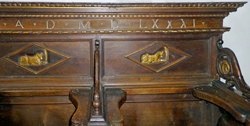
Beatrice Vitelli commissioned these choir stalls for the nuns’ church. They are dated by inscription and carry the Vitelli arms. They were documented in the church on a number of occasions in the period 1728-1878: on the last occasion, they were described as being in the nuns’ choir, which was against the counter-facade and behind a gilded metal grating. They subsequently became part of the civic collection. They were moved to to Santa Maria Maggiore in the 1950s and adapted to fit its polygonal presbytery.
Return to Nunneries of Città di Castello.
Return to Monuments of Città di Castello.
Return to: Walk I

